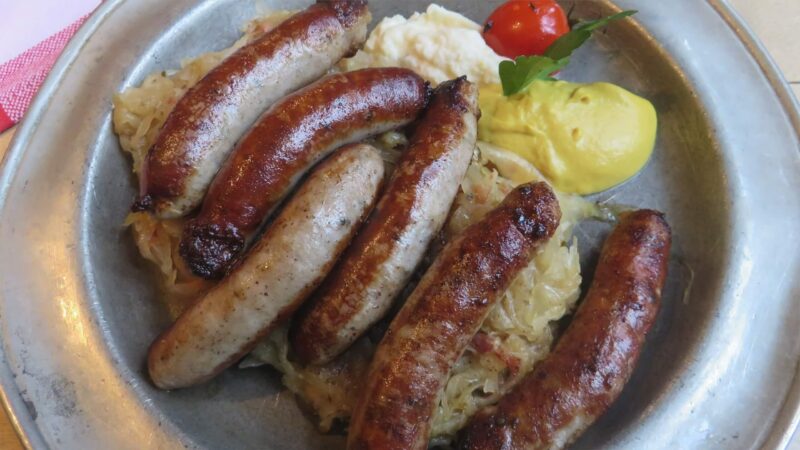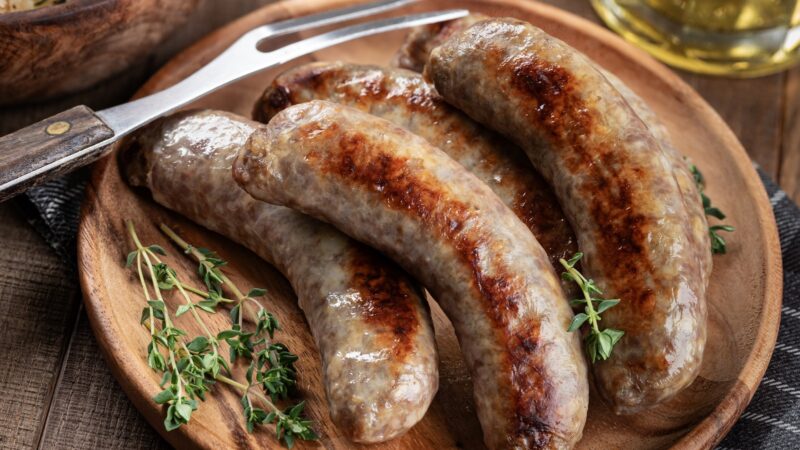Documented evidence of the bratwurst dates back to 1313 in the Franconian city of Nuremberg, Germany. The name “bratwurst” is derived from the German words “brat,” meaning without waste, and “wurst,” meaning sausage.
The creation of bratwurst involved mixing scraps of meat with spices, allowing people to make use of every part of the animal, reducing waste, and creating a flavorful sausage that could be easily preserved.
Since then, multiple varieties of brats have been made up.
Some sources suggest that the first bratwurst was created by a resourceful butcher who combined scraps of meat with spices, while others argue that it may have originated in specific German regions.
Regardless of its origins, bratwurst has evolved over time, with various regions in Germany now having their unique versions of the sausage.
Was Ist Das

The history of sausages dates back to ancient times, with the first recorded sausage recipe appearing as early as 228 AD. However, the bratwurst itself, a specific type of German sausage, has its origins in the 14th century.
The etymology of the word “bratwurst” comes from the Old High German word “Brat,” meaning without waste, and “wurst,” which means “sausage.” This suggests that the sausage was originally created to utilize all parts of the animal, minimizing waste.
The first documented evidence of the bratwurst dates to 1313 in the Franconian city of Nuremberg, Germany.
Nuremberg is still famous for its bratwurst sausages today, characterized by their short and thin appearance. These sausages are typically around 3 inches long, finger-thick, and often served 3 to a roll.
Traditionally, bratwurst is made from a blend of pork, beef, and sometimes veal or lamb. The meat is ground and seasoned with a variety of spices, including salt, pepper, nutmeg, and marjoram.
During medieval times, the fatted pig was generally slaughtered in the autumn, with several sausages eaten fresh and the rest smoked to be saved throughout the year.
Over time, different regions in Germany have developed their own variations of bratwurst, resulting in a wide range of flavors, sizes, and seasonings. Some of the most well-known regional varieties include Franconian bratwurst, Thuringian bratwurst, and Nuremberg bratwurst.
Regional Varieties
- Franconian Bratwurst: Made from a mixture of pork and beef, with distinct flavors of nutmeg, garlic, and white pepper.
- Swabian Bratwurst: A shorter, plumper sausage made from veal and pork, flavored with lemon zest and parsley.
- Bavarian Bratwurst: Featuring a blend of pork and beef, this variety is mildly seasoned with a touch of mustard seeds.
The bratwurst’s culinary significance in German cuisine cannot be understated. Traditionally consumed for breakfast, it can also be found at lunch, dinner, and in street food settings. Typically, bratwurst is grilled, pan-fried, or boiled, and served with sauerkraut, potatoes, or bread. It is often accompanied by mustard, curry sauce (in currywurst), or other regional condiments.
Modern Bratwurst Production

With advancements in technology and industrialization, modern bratwurst production has come a long way from its origins in Nuremberg, Germany.
Today, manufacturers employ new techniques such as advanced meat processing equipment and strict quality control measures ensuring the production of consistently high-quality sausages.
Besides, both the traditional recipe and modern variations coexist, giving consumers a wide range of flavors and styles to choose from.
In keeping with the spirit of innovation, many bratwurst producers pursue the development of unique recipes by infusing sausages with exciting, unexpected ingredients.
As a result, consumers worldwide benefit from an ever-growing selection of bratwurst options made with diverse types of meat, including pork, beef, veal, and lamb.
Global Distribution
As bratwurst has gained popularity around the globe, production and distribution efforts have expanded to satisfy increasing demands. Major bratwurst manufacturers leverage extensive distribution networks to deliver their products to grocery stores, local markets, and specialty shops internationally.
Moreover, the rise of e-commerce and online marketplaces make it possible for consumers to purchase authentic German bratwurst, often made using traditional recipes, from the comfort of their own homes. These advancements in deistribution ensure that fans of this delicious sausage have access to a wide variety of bratwurst, whether they are seeking an authentic old-world flavor or a modern twist on this classic dish.
I’m John Guerrero, with a background in German (Major) and Greek (Minor), leveraging over nine years of translation experience. My academic and professional journey has earned me deep linguistic insights and cultural nuances. I’m very passionate about bridging languages, and always look to deliver content that inspires and informs.

